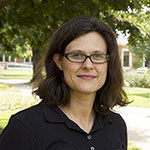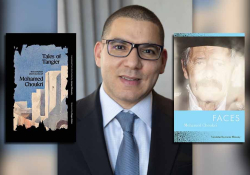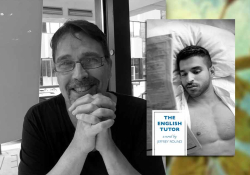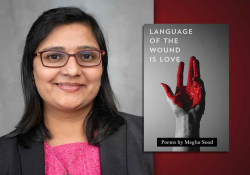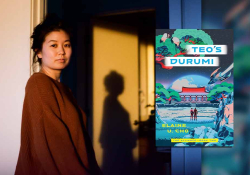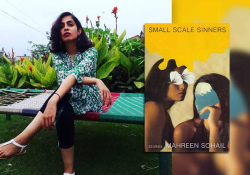Temporary Permanence and Forced Detention: In Conversation with Stephanie Malia Hom
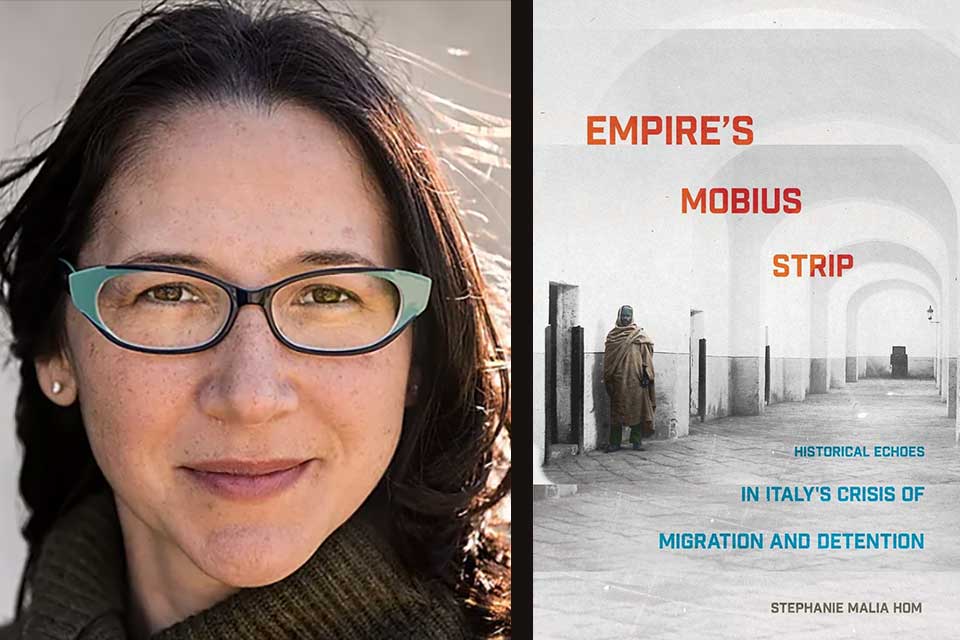
Published by Cornell University Press in 2019 and awarded the 2019 American Association for Italian Studies Book Prize (20th and 21st Centuries), Stephanie Malia Hom’s Empire’s Mobius Strip: Historical Echoes in Italy’s Crisis of Migration and Detention examines the relationship between migration, mobility, and modern Italy. Having previously authored The Beautiful Country: Tourism and the Impossible State of Destination Italy (2015), Hom works at the intersection of many disciplines, tweets @empirestrip, served as Presidential Professor of Italian at the University of Oklahoma, and is currently executive director of the Acus Foundation. In this interview, she considers the power of language to circumscribe and constrain the sometimes contradictory and simultaneous formations of movement, identity, and citizenship.
Andrea Bryant: Our last interview concluded with your mention of Amara Lakhous, an Italian-language writer of Algerian origin whose written work engages with Italy’s struggles in fulfilling its capacity as a multicultural country. In Empire’s Mobius Strip, you give space to the lyrics of Abd El Karim Islam, an artist who has lived in Italy since 1995, and who speaks out against the power of the Italian state. How does the work of Lakhous and Karim intersect?
Stephanie Malia Hom: Both are concerned with giving voice to those in Italy who traditionally have no voice. Lakhous, who was featured by WLT in July 2011, creates a polyphonic tour de force in his most famous work, Clash of Civilizations over an Elevator in Piazza Vittorio (2006), a mystery novel that turns upon the multilingual testimonials of immigrants living in Rome. In his song “Tutto Tace,” Abd El Karim Islam raps about his experience being incarcerated at Ponte Galeria, Italy’s largest migrant detention center. By doing so, he gives a first-person account of what it feels like to be trapped in the limbo of forced detention, and all the feelings of fear, anger, confusion, and resignation explode through his music. Too often these first-person accounts are absent from the contemporary media coverage of migration and detention, which focuses on the spectacle of crisis—think images of refugee camps or border walls—rather than the lived experiences of the people who are caught up in its force field.
Bryant: I sense that Lakhous and Karim experience mobility and constriction of movement differently. How would you conceptualize their respective points along a Möbius strip?
Hom: The fundamental property of the Möbius strip is that it cannot be oriented in time or space, and I intended for it to serve as a metaphor for the sustained disorientation that forcibly displaced people experience over the longue durée. Thus, one’s position along the Möbius strip is always fluid and dependent on context, including those of Lakhous and Karim.
The fundamental property of the Möbius strip is that it cannot be oriented in time or space, and I intended for it to serve as a metaphor for the sustained disorientation that forcibly displaced people experience over the longue durée.
In the course of my research, I discovered an interesting convergence between Lakhous and Karim, which came in the form of silence, that is, the deliberate elimination of language to comment upon identity, mobility, and citizenship. One of the most harrowing episodes of Lakhous’s aforementioned novel, Clash of Civilizations over an Elevator in Piazza Vittorio, is the moment when the character Parviz, an Iranian immigrant, sews his mouth shut after Italian authorities refused to grant him a permit of stay. Five years after the publication of this novel, a group of nine men at the same migrant detention center where Abd El Karim Islam was interned sewed their mouths shut to protest their forced detention. In both of these cases, Parviz and the men who became known as bocche cucite (sewn mouths) literally spoke volumes through their silence.
Bryant: You also cite Rajab Hamad Buwaish al-Minifi, a Libyan poet and survivor of the El Agheila concentration camp, in the contexts of both camp and village. What does this simultaneous inhabitance in two seemingly different realms expose about the limited infinity (or temporary permanence) of the Möbius strip?
Hom: It shows the interconnectedness of all these spaces. The boundaries between them are porous; one does not end at the border of the other. Take the island of Lampedusa, for example, which I focus on in the first essay of the book. It is an eight-kilometer-long limestone shelf in the middle of the Mediterranean, closer to Tunisia than to Italy. It is also the site where hundreds of thousands of migrants, most often arriving at the hands of traffickers in boats from North Africa, first disembark in Europe. Yet the island’s presence is seen and felt well beyond the Mediterranean. Across sub-Saharan Africa, for instance, traffickers’ boats are called lampa lampas. In Germany, a group called Lampedusa in Hamburg has staked a signifying claim on the island, appropriating it to represent social justice for migrants. All represent different points at which the island touches down along empire’s Möbius strip; similar, too, are the examples of the camp and the village.
I also made a deliberate choice to include Rajab Hamad Buwaish al-Minifi’s poetry, not only because I felt it important to include the voice of a survivor of the camps but also because al-Minifi shows how the highest expressions of our human faculties, like poetry, can create beauty out of bleakness. For this reason, too, I decided to end each essay in the book with a work of art, music, and film, respectively.
Bryant: I remain struck by the literariness that your use of the Möbius strip to guide your writing entails. May we know more about your use of how this spatial configuration plays out in the book?
Hom: The original title of the book was “The Empire Between.” I wanted the title to represent the interstices between imperial formations past and present. I actually used the metaphor of the Möbius strip to illustrate a point in my book prospectus, and it was the suggestion of my editor extraordinaire at Cornell University Press, Emily Andrew, to seize on this as the book’s title. From there, everything clicked into place—I used the Möbius strip as the book’s guiding metaphor, which not only clarified the idea of “the empire between” but also gave it a new dimension by embodying both the endless loops of empire and, at the same time, the limbo experienced by those caught up within these imperial formations.
Bryant: Much like your conceptualization of the Möbius strip itself, your use of three novella-like essays, an introduction, and a coda to structure your book is an invigorating one. I’m curious to know more about how you came about the decision to structure your book in this way.
Hom: My goal with this book has always been to show how imperial formations connect the past with the present through the control of mobility, and specifically, Italy’s colonial past in Libya with its present crisis of migration and detention. I grappled for years with how to represent this continuity in writing, trying to fit it into the conventions of academic prose. But that just wasn’t working, so at a certain point I jettisoned any pretense of form and let the writing take me where the book wanted to go. The result was what I call “long-form academic writing” in which novella-like essays give imperial formations room to breathe, so to speak.
Interestingly, I didn’t know what to call this form of writing until I had a chance encounter with the legendary talk show host Dick Cavett in 2017. We talked about his long-form interviews with celebrities and how having the luxury of time opened up possibilities for spontaneous connections, new questions, and unexpected insights. The reward for the audience was to watch these connections, questions, and insights unfold before them: they had been shown, not told. This was my “aha!” moment: showing, not telling, the imperial formations was exactly what I wanted to accomplish in this book.
Bryant: You reveal in a recent interview with Beth Windisch (@bethwindisch) at New Books Network your decision to strip away the theory from the book. This, along with the structure of the book, is a departure from the writing style of the conventional monograph. Which factors were at play in this choice, and which theorists were originally the strongest candidates for inclusion?
Hom: As I mentioned before, I wanted this book to embody the well-known writer’s adage of “showing, not telling.” I wanted the narrative to do the work of the theory: to provide through the act of reading a sense of temporary permanence, exclusion, and marginalization, that is, to feel the very lived consequences of empire.
Earlier drafts of the manuscript, however, contained a number of long, complicated sections on theory, including ones that engaged with Giorgio Agamben’s notions of Homo sacer and the concentration camp, Michel Foucault’s biopolitics and governmentality, John Urry’s mobilities paradigm, and Rosi Braidotti’s nomadic theory, to name a few. In hindsight, I realize that I had to write through the theory in order to understand it, after which I could choose either to distill or remove it. A few short distillations remain in the book, mostly in the notes, but for the most part, I stripped away the theory to allow for the narrative to do the work.
Bryant: Speaking of theory, I have been contemplating why you may not have used Baudrillard, whose work on simulacra you previously expanded. I would be very happy to know more about how the constellations of tourism and imprisonment interrelate within the framework of the book.
Hom: Baudrillard ended up on the cutting-room floor! I actually wrote a fourth essay about colonial exhibitions and postcolonial museums, “The Fair,” to be included in the book. It examined the relationship between hyperreality and empire, and specifically how exhibitions and museums, as built expressions of Italian colonial ideals, harnessed simulation in service to imperialism. Yet the actually existing people caught up in the bind between simulation and imperialism—like the colonial subjects put on display at exhibitions, or objects of a colonizer tourist gaze—were treated as hyperreal subjects, who, in the words of Baudrillard, were always already dead. In the end, I decided this essay detoured readers too far away from the more pressing constellations of empire’s Möbius strip, and I cut it from the book. If you’re interested, I published an abbreviated version of the omitted essay in the volume Neocolonialism and Built Heritage: Echoes of Empire in Africa, Asia, and Europe, edited by Daniel Coslett and released by Routledge in 2019.
Bryant: In the course of reading your book, I became aware of the metaphorical and bureaucratic power that language holds over individual choice, citizenship, and movement. You mention that the line between the free and the imprisoned often hinges on chance and circumstance. Is there an example you have encountered (either personally or through archival research) that most dramatizes this fact?
Hom: While conducting research for this book, I lived for extended periods of time in Italy and Greece, two countries that have been on the front lines of Europe’s migration crisis for years. When I first arrived in Rome, I went to the questura (police headquarters) on the outskirts of the city where I was to register for my permesso di soggiorno (permit of stay). A line of hundreds of people—all extracomunitari (non-EU citizens) like myself—stretched around the perimeter of the building. Yet by dint of the passport that I held, the color of my skin, the language that I spoke, and the institution I was a member of, I jumped the queue and received my paperwork without issue. I was accorded the privilege and the power of movement by choice.
It was this experience that opened my eyes to mobility-generated inequality and that animated me to work to redress that injustice. I decided to use my privilege to go deep into places where equality is occluded and to write about what was happening there: places like the islands of Lampedusa and Kos and the migrant detention centers at Ponte Galeria (Rome) and Amygdaleza (Athens), for example. While I cut the Greece material from the final manuscript, it helped me grasp just how insidious and extensive was the reach of empire’s Möbius strip.
I decided to use my privilege to go deep into places where equality is occluded and to write about what was happening there.
Bryant: Your essay on the camp scaffolds off an earlier article titled “Becoming Ospite: Hospitality and Mobility at the Center of Temporary Permanence,” which appears in Italian Mobilities, an edited volume you and Ruth Ben-Ghiat (@ruthbenghiat) co-edited and published through Routledge in 2015. In both chapter and essay, you consider how classificatory labels, together with the grammar of state power, mediate mobility and trauma. I am mesmerized by how the term ospite, which means “guest” in Italian, does not carry the positive associations rendered by traditional understandings of hospitality. Could you explain more about how this designation works?
Hom: Today we often associate the word “hospitality” with tourism. When we hear the term “hospitality industry,” we think of an economic sector built to cater to people who can move by choice. Guests are welcomed by hosts, and hosts take pride in providing guests with service and generosity.
Yet we forget that the etymological root of “hospitality” is, in fact, the same as that of the word “hostility.” To be hospitable and to be hostile are fundamentally linked to each other. So close were these concepts in Latin, keeping with etymology, that a stranger could be a “guest” (hospes) and an “enemy” (hostis). Given this double nature of hospitality, then, it was not at all surprising to me to find that those who are moved by force, like refugees and asylum-seekers, and who happened to be immobilized in migrant detention centers across Italy, were referred to as ospiti, that is, the perfect combination of hospes and hostis.
Bryant: In addition to the irony associated with ospite, your ethnographic descriptions of life in prisons, camps, and villages are often indistinguishable from one another in terms of freedom of choice and movement rendered upon the individuals held in captive there. What, if any, are the main demarcations between these categories?
Hom: I sought to emphasize the fluidity between these categories insofar as they all exist in a state of temporary permanence. They feel the same to the people who inhabit or transit through them. Yet some sites, like the village, which may have once started out as temporary, have transformed into places that are more fixed and permanent. I started to explore this transition from temporariness to permanence in the last essay of the book; however, I plan to explore it more fully in a future research project on Italy’s profughi nazionali (national refugees).
After World War II, Italy was home to the most extensive—and now forgotten—system of refugee camps in Europe, which housed upward of three hundred thousand people and lasted until 1970. Italians returning from the colonies, along with those displaced from Istria (Croatia), and those who returned from concentration camps in Germany and Poland, were designated “national refugees” and sent to live in camps across Italy. State-funded housing complexes gradually replaced these camps, thus affixing the lives of these national refugees to these once-temporary spaces. Most scholarship focuses on refugee camps as spaces of humanitarian emergency; I ask, instead, what does it mean to exist as a refugee apart from a state of emergency, when the temporary is rendered permanent, when one’s history as a refugee is discounted or forgotten? These are but a few of the questions I intend to take up in my next project, continuing my exploration of the Möbius strip along a new trajectory.
Bryant: As you point out, your book brings to light the neglected aspects of colonialism and genocide that are a part of Italian history. I am curious to know how, in your estimation, Italy’s past as a mobility regime might affect its future course.
The global crisis wrought by the coronavirus sheds light on just how central the freedom of movement has become to twenty-first-century life.
Hom: As I answer these questions in March 2020, the whole of Italy is on lockdown because of the coronavirus. No one can leave their homes, save for medical treatment or provisions. The movements of all people are blocked. Lives are suspended in limbo, not unlike the lives of the migrants I describe in the book. It is the age of the quarentena (quarantine). Mobility, yet again, emerges as the main dividing factor of our time, and the global crisis wrought by the coronavirus sheds light on just how central the freedom of movement has become to twenty-first-century life.
The resonances between the coronavirus pandemic and the migration crisis are striking, too. The rhetoric of contagion, contamination, and spread, for instance, has been used to characterize both the coronavirus and “illegal” immigration. In both cases, there has also been, to varying degrees, a fearful response to an unseen enemy, whether that is a viral droplet or shadowy masses of migrants. Similarly, states are using “hygiene” to justify measures that curb mobility in the name of public security, such as the aforementioned quarantine of Italian citizens or the forced internment of “illegals” in migrant detention centers.
Granted, the novel virus absolutely necessitates a public health response that includes social distancing and self-isolation; however, I am left to wonder if the panic emerging in response to the virus—this unknown, unseen enemy—has been fomented by years of public conditioning against “illegal immigrants” in both politics and the media. In other words, I ask if the coronavirus is reaping the hysteria that was sewn into our consciousness years ago vis-à-vis the crisis of migration and detention.
I am left to wonder if the panic emerging in response to the virus—this unknown, unseen enemy—has been fomented by years of public conditioning against “illegal immigrants” in both politics and the media.
Bryant: Your discussion of how the imperial formations of prison, camp, and village equally applies to the United States finds deep resonance. Do you foresee your groundbreaking conceptualization of the Möbius strip being applied to work on the United States?
Hom: I hope so, and in fact, it’s hard for me not to situate the United States within empire’s Möbius strip. One of the examples I cite in the book’s coda—Fort Sill, Oklahoma—where Apache, Comanche, and Kiowa tribespeople were imprisoned in the mid- to late nineteenth century, was recently proposed as a detention center for migrant children in 2019. To draw a connection between the centuries-long sequestration and genocide of Native Americans in this country and the sustained, exclusionary violence against migrants today is not a very far leap.
March 2020
Editorial note: Read Bryant’s first conversation with Hom here.
Stephanie Malia Hom is an academic and nonprofit executive. She writes and lectures on modern Italy and the Mediterranean, mobility studies, colonialism and imperialism, migration and detention, and tourism history and practice. She is the author of several books, including Empire’s Mobius Strip: Historical Echoes in Italy’s Crisis of Migration and Detention (Cornell University Press, 2019). Her essays and articles have been published in a wide range of venues, including the leading journals in the fields of Italian studies, tourism history, urban studies, and folklore. She has also worked as a journalist in the US and Europe.
